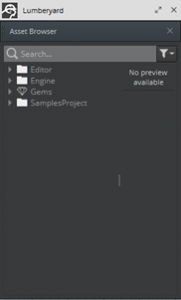The Editor
The Editor
Lumberyard’s Editor provides developers with different tools and editors to build a project. Some of the basic steps include creating a new level and adding new entities with different components to the level. Different tools and editors can help developers solve different problems. Lumberyard uses Lua as the scripting language which comes with an in-built editor. There are various components available including AI, animation, audio, camera, environment, network, physics, rendering, scripting, shape, UI, VR, and many more.
Maneuvering The Perspective Window
To navigate within the Editor is simple. It is very similar to a First-Person Shooting game.
| Input Device | Key | Function |
|---|---|---|
| Keyboard | W | Strafe forward |
| Keyboard | S | Strafe back |
| Keyboard | A | Strafe left |
| Keyboard | D | Strafe right |
| Mouse | Left | Select/Marquee select |
| Mouse | Middle + Direction | Pan direction |
| Mouse | Right + Direction | Look direction |
| Mouse | Scroll wheel | Zoom in and out |
| Key | Description |
|---|---|
| Q | Toggle the camera or terrain collision |
| Z | Focus the camera to the selected object in the viewport |
| F3 | Toggle the wireframe view |
| Alt + Middle mouse button | Rotate around the selected object |
| Alt + right click | Zoom in and out |
| Ctrl + Tab | Cycle the viewport perspective |
| Ctrl + F1 (or F2, F3, …,F12) | Save the viewport location |
| Shift + F1 (or F2, F3, …, F12) | Move to the saved viewport location |
| Shift + Space | Show or hide helpers |
Resources
Editor Basics
The image below gives a brief overview of how the Lumberyard Editor is laid out. We will discuss the individual parts of the Editor.
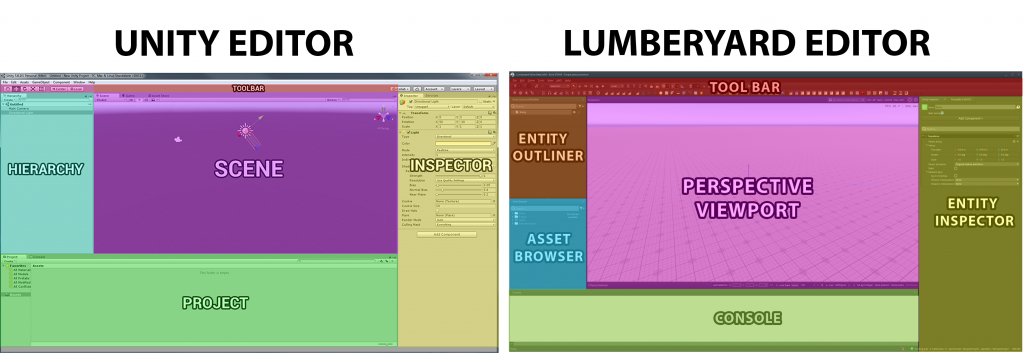
Main Menu & Editor Toolbar
The Main Menu contains the standard functionalities and settings of any application. Through the main menu, you can edit the current level or project that is open, change the layout of the Editor, and access any tools and editors available in the interface.
The Editor Toolbar contains the most commonly used tools and editors within Lumberyard. For example, select, move, rotate and move entity functions, open layer, material and animation editor, and flow graph.
Perspective Viewport
In the Perspective Viewport, you can view and edit entities you want and lso control the viewpoint by navigating within the level. The Viewport further includes a header and a control bar.
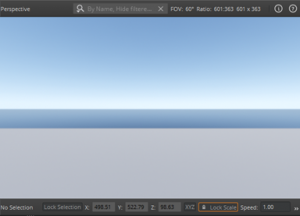
The header at the top provides different mounts of information for three modes that you can switch between by clicking. You can toggle display help (Shift+Space) to show or hide helper objects, and also search for any entity within the level by typing it in the search bar.
The perspective control bar at the bottom lets you edit the position of selected entities and also lets you modify the speed of navigating within the Viewport. Some other functions include:
- Switching on the lock selection button (key B) can prevent you from inadvertently selecting something else in a level.
- Switching on the lock scale button (key D) can prevent you from changing the ratio of the entity’s length, width and height. You can still scale it up and down.
- The AI/Physics button lets you simulate the two systems without actually starting the game. This is very helpful in unit debugging before testing out the systems as a whole.
- Switching on the No Sync Player button (key H) can detach the player entity from the camera. The No Sync Player function can be useful with AI or Physics enabled, when you don’t want to activate triggers while navigating through a level.
- Goto position (key I) helps you view a certain position.
- While Mute Audio button (key J) should mute all sounds in the level, this feature doesn’t work as expected and is unable to mute all audio at all times.
- The VR Preview button (K) previews your game project in virtual reality mode when a virtual reality gem is enabled.

Rollup Bar
The rollup bar is a legacy feature but contains some important and useful functionalities. There are 5 tabs in rollup bar:
- Objects – contains options for various brushes, entities, volumes, prefabs and more.
- Terrain – contains tools for sculpting and painting terrain, adding vegetation and creating rivers and roads.
- Modelling – helps edit meshes that support the mesh editing.
- Display – contains options for rendering settings, 3D display settings, and hide settings for various types of objects and entities in Lumberyard.
- Layers – helps arranging the layers.
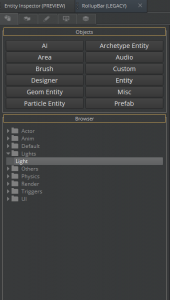
Entity Inspector
The entity inspector displays all the components of a selected entity and allows developers to add/delete/enable/disable/edit these components. The “Start Active” option is how to disable an entity on start, and to enable the entity in play requires a scripting event. The search bar allows filtering for certain components, however because Lua scripts are attached to Lua components, scripts cannot be searched for directly. The Entity names can be changed here, however the ID is static and cannot be modified by the developer (the ID has been hidden in version 1.13). The green icon to the left of name is the icon which is displayed in the Perspective Viewport, and is able to be customized. There is a pin icon to the right of the name (v1.13) which opens an inspector window for that entity that won’t change after selecting another entity.

Entity Outliner
The Entity Outliner contains the entity hierarchy of the level. Entities can be renamed and reparented from the outliner. The entities can be parented and which will be seen visually as a drop-down. Enity slices will have their name highlighted in dark blue, and the children of the slice will be highlighted in a slightly lighter blue. The eye icon to the right of on an entity denotes whether it is visible while editing, it has no effect on visibility during playing the game (see above “Start Active”). The lock icon to the right of the eye determines whether the entity can be clicked within the Perspective Viewport or deleted from the Entity Outliner, however does not stop the entity from being edited from within the Entity Inspector. Both the eye and lock icons have hierarchical functionality, meaning hiding a parent entity will hide that entity along with the children. Entities can be filtered through the search bar and the filter icon. The search filters by name of entity as well as named components, however as mentioned above Lua script names cannot be searched for.
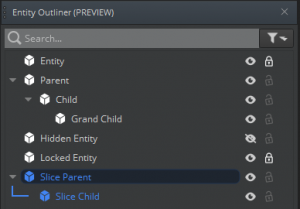
Asset Browser
The asset browser displays all the assets present both in the project folder as well as the ones present engine-wide. Assets can be selected from the browser and dragged into the Perspective Viewport, but not into the Entity Outliner. Modifying files located in the Editor, Engine, or Gems folder will modify the file for the current project as well as any other project using that file. Files located in the project named file are only accessible in the specific project. Files can be filtered and searched for, and the arrow keys also work for navigating files (with down expanding a folder and up jumping to the parent). The Asset Browser also provides a preview of a selected file, in the case of a mesh it will display the mesh, however it will not preview materials (see Material Editor). Files cannot be moved/deleted from the Asset Browser, rather with a right-click can be accessed from the file explorer where they can be moved/deleted.
